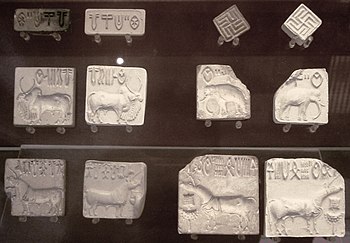Indus seal

As Indus seal is referred by the Indus civilization produced seal . The Indus culture is not particularly rich in monumental works of art. There are numerous, rather modest clay figures, a few stone sculptures and, above all, the architecture of the cities, which demonstrate a high cultural level. In addition, it is above all the numerous seals that can be assessed as a direct expression of the artistic sensibility of the Indus culture. Seals are of great importance in the art of the Near East . They are often labeled and decorated with scenes that provide valuable clues about history, mythology, and social organization.
The first seals of this culture appeared in the excavations of Alexander Cunningham in Harappa in 1875 , but were not taken into account at that time. It was not until 1912 that they aroused the interest of science when the British Museum acquired some of these seals and published them by JF Fleet. Since then, several thousand of these seals have been found and, along with the architecture, they are considered to be the most original creation of the Indus culture. They also refute that the Indus culture was monotonous and inexpressive, as has often been claimed.
The Indus seals are usually relatively small (from approx. 1.5 to 4 cm², but most around 2.5 cm²) and usually square. They are largely made of steatite , although specimens made of frit , silver, marble, calcite, limestone and clay are also documented. On the front there is usually a picture of an animal. The most popular was the unicorn , which was more likely a stylized representation of a cow. The unicorn is almost always represented with another object. The identification of this object in front of the unicorn is difficult. Perhaps it's a stand with offerings. In addition to the unicorn, other animals appear as the only motif on the seals, but much less often, e.g. B. Elephants, the tiger and the crocodile. Human figures, which are mostly interpreted as deities, are rarer. Above these figures there are usually signs of the Indus script . In fact, the seals are the primary source for this scripture.
As various finds show, the Indus seals were actually used as seals and not just as amulets. They obviously signaled ownership and possession.
See also
literature
- Ute Franke-Vogt: The glyptic of the Harappa culture . In: Günter Urban (ed.): Forgotten cities on the Indus. Early cultures in Pakistan from the 8th to the 2nd millennium BC Chr. Von Zabern, Mainz am Rhein 1987, ISBN 3-8053-0957-0 , pp. 187-195.
Web links
- Siegel from Harappans (Engl.)
- Gallery with images of seals (note: the two bottom left are dated approx. 2000 years later and are coins)